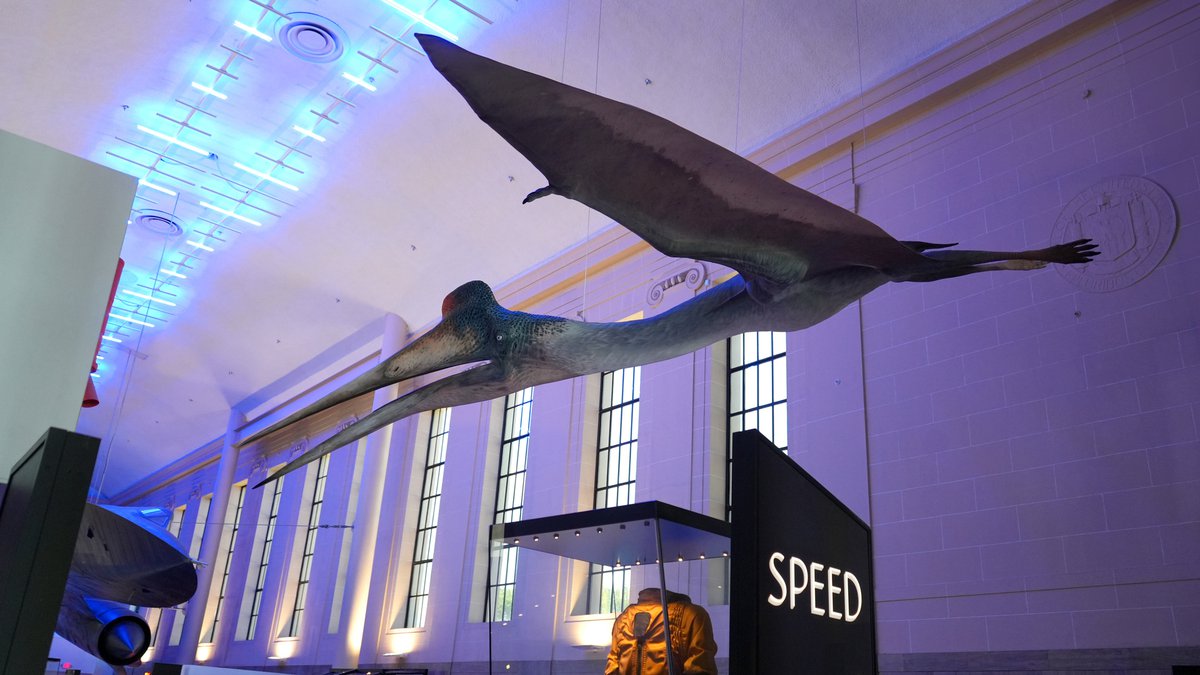Quetzalco ... WHAT?!?
Are snakes, spiders and chipmunks the same thing? No! Do they live in the same places at the same time? Yes!
It’s the same for dinosaurs and pterosaurs. Pterosaurs are not dinosaurs, but they are prehistoric flying reptiles who lived alongside dinosaurs.
People expect to see dinosaurs in science museums. The Science Museum of Virginia is unexpected, so we didn’t install a dinosaur. In late April 2024, we installed a type of azhdarchid pterosaur called Quetzalcoatlus northropi.
What a name, right?! It’s OK if you don’t say it quite right on the first try. Here’s a pronunciation guide to help you out: ket-zel-co-WAT-luss NORTH-rup-eye.
Azhdarchid pterosaurs lived in the Late Cretaceous Period, about 100.5–66 million years ago. This was around the same time as the mighty Tyrannosaurus rex and massive Triceratops horridus roamed the Earth.
The Quetzalcoatlus is the largest known flying animal. It had a wingspan of between 33-36 feet and was up to 18 feet tall, which is taller than most giraffes. Even with its massive weight–approximately 500 pounds–the Quetzalcoatlus flew at speeds of approximately 65 miles per hour.
With wings that large, you might think the Quetzalcoatlus spent most of its time in the air, but it lived and hunted on land. When walking, it folded its wings and walked on four feet. Here’s another way these ancient animals were different from dinosaurs: pterosaurs were plantigrade, meaning they walked with their heels on the ground. Dinosaurs were toe-walkers, called digitigrade. The Quetzalcoatlus likely hunted for prey (it probably munched on small dinosaurs) on the ground similar to modern birds like the stork or shoebill.
Quetzalcoatlus fossils were first discovered in Texas in 1971. The genus name, Quetzalcoatlus, comes from the Aztec feathered serpent god, Quetzalcoatl. That’s pretty fitting for a creature that quite literally is a flying feathered lizard! The species name honors John Knudsen Northrop who founded Northrop Corporation and developed large, tailless flying aircraft designs which resemble Quetzalcoatlus.
There are two species of Quetzalcoatlus. The Science Museum model is of the Quetzalcoatlus northropi however there is also a smaller species known as the Quetzalcoatlus lawsoni.

The Science Museum has not one but two models of the Quetzalcoatlus northropi: a 3-D and 2-D sculpture. Our flying 3-D model helps guests gain a better understanding of how the massive pterosaur moved as well as visualize its mighty wingspan. Displaying the 3-D sculpture in the Speed exhibition across from the impressive SR-71 puts them in conversation with each other. It gives insight into two different aerial entities from very different sources (human-made vs. natural) and from vastly different time periods (75 years ago vs. 75 million years ago).
We not only have the largest Quetzalcoatlus in the world but it is also the only one produced with its mouth open. Due to a custom paint job, the Science Museum's Quetzalcoatlus is truly unique.
Our 2-D sculpture stands at 18 feet tall and helps guests visualize the immense height of the creature. Both sculptures were crafted by Blue Rhino Studio in Minnesota, a top-manufacturer of scientifically accurate prehistoric creature sculptures.
So there you have it! While not a dinosaur, the new Quetzalcoatlus certainly is DINO-mite, and worth a visit to the Science Museum to see it very soon.
Communications intern Blaise Wingold contributed to this blog.


